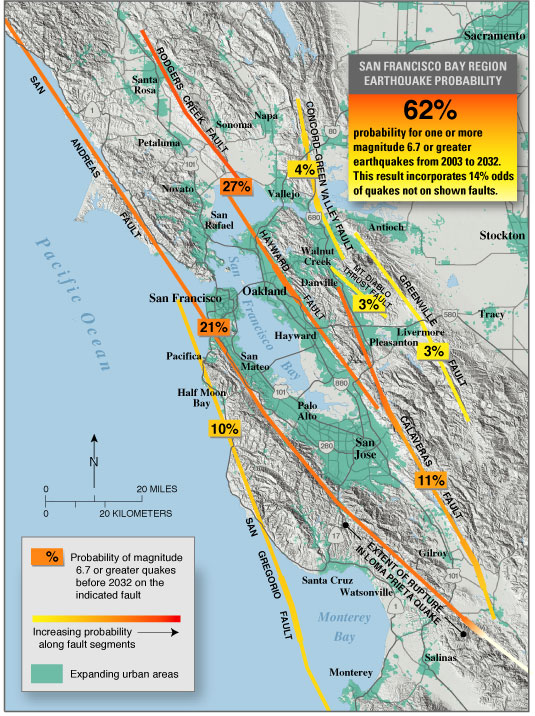San Francisco, located in the region of North California, is known to be the financial and cultural hub of the Bay Area. Interesting enough, San Francisco is the only city in California to make up a whole county. In addition, it consists of the second most dense population in the United States at more than 17 thousand people per square mile, so you can imagine the New York feel of crowdedness in the heart of downtown San Francisco. If you want to avoid the heat, yet in a place where it doesn't get too cold, I would recommend living in San francisco. The weather stays at a cool temperature year round. I was even a bit chilly during the daytime when I visited the city in the middle of August.
source: http://www.demographia.com/db-2000city50kdens.htm
-----------------------------------------------------------------------------------------------------------------
Geography 321 San Francisco
Chapter 2: Environmental Setting
Geography
One of the biggest reasons why visiting San Francisco was so memorable was because the whole city is surrounded by water. Within its boundaries stretch the Pacific Ocean to its west and The San Francisco Bay to its east. What was more fascinating was that the city also consists of several islands such as Alcatraz.Another thing that makes San Francisco so unique is that it is famous for being so hilly. The city consists of more than 50 different hills. In fact, these hills can reach up to 1000 feet in height and so the temperature can actually vary within different parts of the city.
Unfortunately to consider, the city is very prone to having Earthquakes. From Southern California, the San Andreas fault stretch through the area we live in all the way up through the Bay Area. Much like Los Angeles, San Francisco had their fair share of large earthquakes.
Climate
 |
| San Francisco Surrounded by large water bodies |
source:
http://www.sfgate.com/entertainment/article/PEAK-EXPERIENCE-2636879.php
http://www.nps.gov/alca/index.htm
-----------------------------------------------------------------------------------------------------------------
Chapter 3: Historical Settlement
 |
| A paint of the bay area before European Contact |
| San Francisco Mission |
Jumping ahead about 50 years, the Spanish people gained their independence from Spain and became the nation of Mexico. However, California did not stay part of Mexico for much long, when only about 25 years later the United States acquired all of California and other neighboring states through the Treaty of Guadalupe Hidalgo. At this period of time, The San Francisco Bay Area saw its second drastic change, but this one would take it toward what San Francisco is today.
The California Gold Rush helped the small settlement became a city of gold seekers. A flood of Americans from the east would flood the California Coast and the city would forever be white dominant. The city thereon bloom into one of the largest business and ethnic hubs in the country.
Today, San Francisco is a very welcoming city to overseas immigrants. For example, a large group of Chinese immigrants helped form the very well known Chinatown in the city. On the other hand, San Francisco of late has been known to have a very high cost of living causing many middle/lower class citizens t o move out to suburbs within the Bay Area.
source:
http://web.archive.org/web/20060301022510/http://sfgov.org/site/visitor_index.asp?id=8091
http://www.sfmuseum.org/hist1/early.html
http://www.sfmuseum.org/hist1/brick.html
-----------------------------------------------------------------------------------------------------------------
Chapter 4: Political Economy
Yes, you may enjoy the cool weather of San Francisco, but it is not the only reason why I recommend visiting or vacationing in the city. Well it is not a coincidence that the largest tertiary-sector employer in the city would be tourism. San Francisco actually attracts the fourth largest number of foreign tourists in the whole United States. In my own opinion and experience, the reason why tourists are so attracted to the city is because there are an endless amount of sightseeing. Not only does it have the many beautiful sceneries of the bay and skyline, it also has the countless number of landmarks and unique ethnic districts. You can even visit historical sites, like the famous district of Haight-Ashbury.
 |
| Haight-Asbury: known to be the center of the Hippie Movemenet |
Another big business in the tertiary-sector is their banking business. Thanks to the California Gold Rush, San Francisco became a very big banking and financial center in the west coast. In fact, Montgomery Street became known as "the Wall Street of the west". The city is home to many well known banks today such as Wells Fargo and The Pacific Stock Exchange. Even Bank of America was founded in the city.
The final factor to consider in San Francisco's economy is the Dot-Com Bubble. In the 1990s, the internet began to flourish and many businesses related to the field began to pop up in the Bay Area. Many large companies that we know today have started up in San Francisco like Craiglists, Twitter, and Wikpedia.
With all these factors considered, it is no wonder San Francisco is such a notable city in the United States and even the world. It has a very interesting mix between its ethnic and fiancial districts.
source:
http://www.sfgate.com/business/article/S-F-tourism-picks-up-but-spending-stays-flat-3253943.php
http://www.sfgate.com/bayarea/article/New-jobs-houses-spur-S-F-population-in-2007-3284112.php
-----------------------------------------------------------------------------------------------------------------
 |
| Financial District |
With all these factors considered, it is no wonder San Francisco is such a notable city in the United States and even the world. It has a very interesting mix between its ethnic and fiancial districts.
source:
http://www.sfgate.com/business/article/S-F-tourism-picks-up-but-spending-stays-flat-3253943.php
http://www.sfgate.com/bayarea/article/New-jobs-houses-spur-S-F-population-in-2007-3284112.php
-----------------------------------------------------------------------------------------------------------------
Chapter 5: Political Geography
 San Francisco, as already mentioned, is the only consolidated city/county in California. Therefore, the mayor of the city is also the county executive, while the Board of Supervisors acts as the city council. It is also worth mentioning that San Francisco is known to have a majority of democratic supporters like California as a whole In fact, the city is one of the centers for liberal activism and progressive movements. The Bay Area is actually regarded to be one of the most liberal areas in the country.
San Francisco, as already mentioned, is the only consolidated city/county in California. Therefore, the mayor of the city is also the county executive, while the Board of Supervisors acts as the city council. It is also worth mentioning that San Francisco is known to have a majority of democratic supporters like California as a whole In fact, the city is one of the centers for liberal activism and progressive movements. The Bay Area is actually regarded to be one of the most liberal areas in the country.When looking at the population distribution in the Bay Area it is very clear that the population are densest along the bottom half of the bay. The North Bay Area is clearly a lot less populous, where only some suburbs exist.
Demographics
San Francisco is one of those cities that is a minority-majority population meaning non-hispanic whites do not hold majority of the population. This is not necessarily a good or bad thing. It just means that San Francisco is a very ethnically diverse city. The largest minority group in the city are Asians which about a third of the population. Also the city has the largest amount of gay/lesbian individuals within the top 50 most populous cities in the United States. These factors significantly contribute to why the area is so liberal.
| Chinatown |
Source:
http://sf311.org/index.aspx?page=262
http://web.archive.org/web/20070703111703/http://www.sfgov.org/site/bdsupvrs_index.asp?id=4385
http://www.census.gov/population/www/documentation/twps0076/twps0076.html
http://web.archive.org/web/20070702202709/http://www.law.ucla.edu/williamsinstitute/publications/SameSexCouplesandGLBpopACS.pdf
-----------------------------------------------------------------------------------------------------------------
Chapter 7: Natural Hazards
Earthquakes
One of the most obvious natural hazards that the people in the Bay Area face are earthquakes. Some of the issues to consider for having an earthquake in that region are:
Flooding/Mudslides/Landslides
These factor on the other hand are commonly considered throughout many areas of the United States. The San Francisco Bay Area has experienced some flooding due to improper drainage. However, flooding is more frequent in the North Bay Area because its average rainfall is noticeably higher.
Some areas in the Bay Area that are considered to unstable have become urbanized so people living there have to be very precautious to the likelihood of mudslides and landslides. These problems are very common in the Santa Cruz Mountains.
Windstorms/Wildfires
In both late fall and early spring, the San Francisco Bay Area can experience very strong pacific storms. These storms can be hazardous because it can blow down trees and power lines which can cut off necessary power to people. Also strong winds can spread wildfires uncontrollable, especially in the fall when vegetation is the driest.
Source:
http://quake.abag.ca.gov/
http://earthquake.usgs.gov/regional/nca/1868virtualtour/bayarea.php/
http://www.sfmuseum.org/oakfire/berkeley.html
-----------------------------------------------------------------------------------------------------------------
One of the most obvious natural hazards that the people in the Bay Area face are earthquakes. Some of the issues to consider for having an earthquake in that region are:
- The handful of faults that go through the region.
- A very high likelihood of a major earthquake hitting the region within the next 30 years.
- Some areas include very bad soil conditions which can result in more damage.
- Many buildings do not meet the required earthquake code to withstand such a large earthquake.
- Tsunami, a less likely factor but still should be considered because the city is along the coast of the Pacific Ocean.
Flooding/Mudslides/Landslides
These factor on the other hand are commonly considered throughout many areas of the United States. The San Francisco Bay Area has experienced some flooding due to improper drainage. However, flooding is more frequent in the North Bay Area because its average rainfall is noticeably higher.
Some areas in the Bay Area that are considered to unstable have become urbanized so people living there have to be very precautious to the likelihood of mudslides and landslides. These problems are very common in the Santa Cruz Mountains.
Windstorms/Wildfires
In both late fall and early spring, the San Francisco Bay Area can experience very strong pacific storms. These storms can be hazardous because it can blow down trees and power lines which can cut off necessary power to people. Also strong winds can spread wildfires uncontrollable, especially in the fall when vegetation is the driest.
Source:
http://quake.abag.ca.gov/
http://earthquake.usgs.gov/regional/nca/1868virtualtour/bayarea.php/
http://www.sfmuseum.org/oakfire/berkeley.html
-----------------------------------------------------------------------------------------------------------------
Chapter 8: Transportation
Transportation is probably one of my favorite topics regarding the city of San Francisco. Living in Los Angeles almost all my life, I was caught by surprise with the extent of how dedicated transportation is in the city San Francisco. In Los Angeles, you cannot reach most of your destinations without a car, and from experience getting from point A to point B using the LA metro system tends to be inefficient. However when visiting San Francisco I was able to get to any point of city that I wanted using a 3-day bus pass. Not only were there a source of transportation to every location I wanted to reach, there were many times more than one form of transportation to get there.
The Forms of Public Transportation
It is an interesting fact that about 32% of San Francisco residents use public transportation to and from work, which ranks it 3rd in the United States and first in California. Like the Los Angeles Metro, San Francisco transportation program is called Muni or San Francisco Municipal Railway. The Muni which is the 7th largest transit system in the United States consists of light rail, subway, a bus network, and streetcar line. Cable cars are also another form of transportation but it would make sense for residents to ride them. It is known more to be a tourist attraction. When I visited San Francisco it actually took about an hour to get one of the cable cars so I cannot imagine why someone would use as a form of real transportation. What I also have found to be fascinating is the Transbay Tube. This line runs underwater across the San Francisco Bay.
Not only is travel extremely accessible through public transportation around the city, it has lines that go to other major parts of the Bay Area. Similarly, Chicago part of the Great Lakes/Corn Belt region, also has an extensive transportation system
Source:
http://www.sfmta.com/cms/rsrtp/documents/09Chapter4-CurrentServiceaccessible-fy08PublicDraftforMTAB10-2.pdf
http://www.sfgate.com/traveler/guide/transportation/publictrans.shtml
-----------------------------------------------------------------------------------------------------------------
The Forms of Public Transportation
It is an interesting fact that about 32% of San Francisco residents use public transportation to and from work, which ranks it 3rd in the United States and first in California. Like the Los Angeles Metro, San Francisco transportation program is called Muni or San Francisco Municipal Railway. The Muni which is the 7th largest transit system in the United States consists of light rail, subway, a bus network, and streetcar line. Cable cars are also another form of transportation but it would make sense for residents to ride them. It is known more to be a tourist attraction. When I visited San Francisco it actually took about an hour to get one of the cable cars so I cannot imagine why someone would use as a form of real transportation. What I also have found to be fascinating is the Transbay Tube. This line runs underwater across the San Francisco Bay.
Not only is travel extremely accessible through public transportation around the city, it has lines that go to other major parts of the Bay Area. Similarly, Chicago part of the Great Lakes/Corn Belt region, also has an extensive transportation system
 |
| Transbay Tube |
http://www.sfmta.com/cms/rsrtp/documents/09Chapter4-CurrentServiceaccessible-fy08PublicDraftforMTAB10-2.pdf
http://www.sfgate.com/traveler/guide/transportation/publictrans.shtml
-----------------------------------------------------------------------------------------------------------------
Chapter 9: The City and its Culture
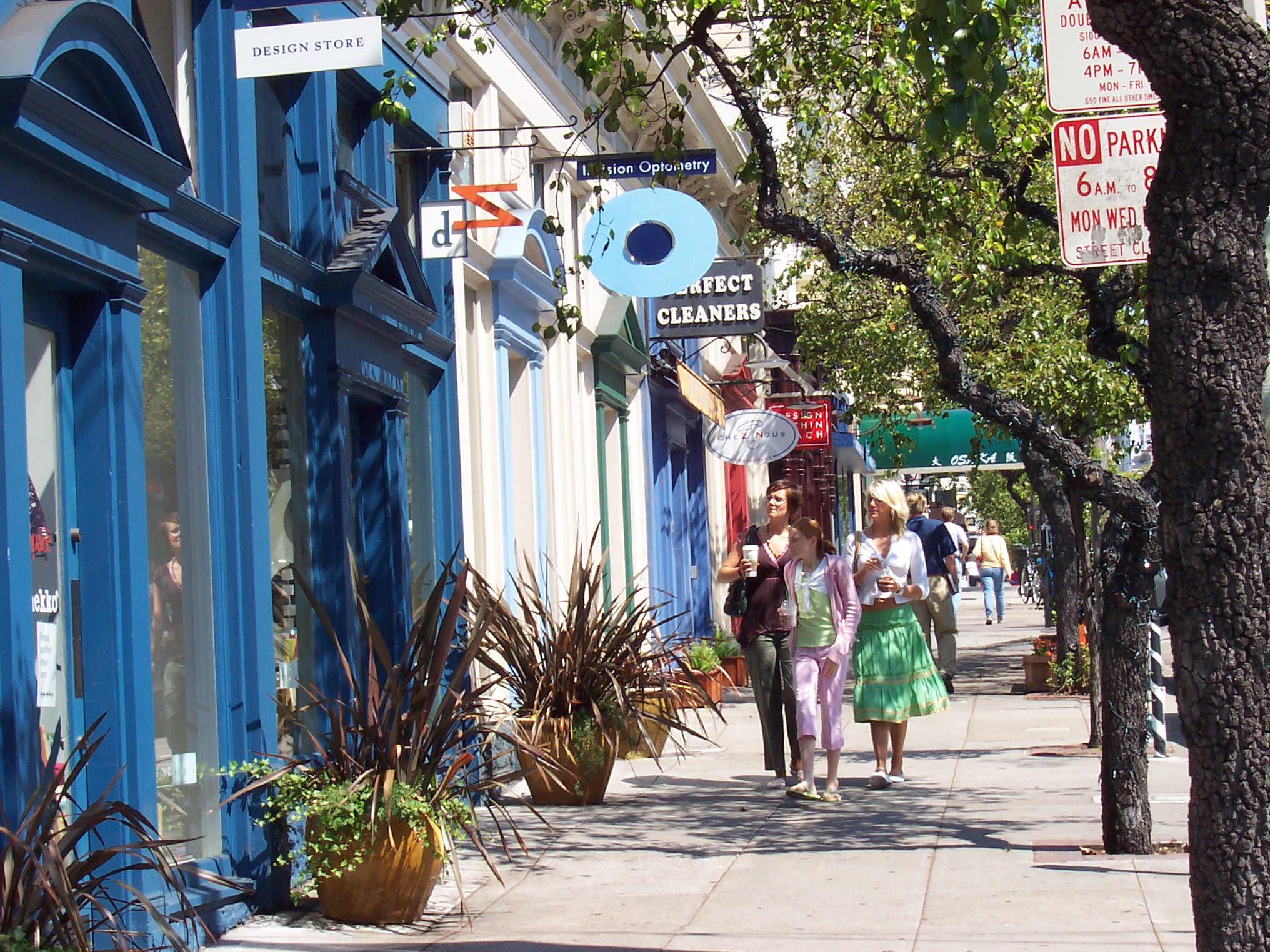 San Francisco is very well known for its culture status. When you walk around the city, it will be apparent that the city has a culturally fascinating streetscape. Whenever I see images of the city streets, it is very easy to identify that the photos are taken in San Francisco. The architecture of the buildings and design of the streets make the city easily distinguishable.
San Francisco is very well known for its culture status. When you walk around the city, it will be apparent that the city has a culturally fascinating streetscape. Whenever I see images of the city streets, it is very easy to identify that the photos are taken in San Francisco. The architecture of the buildings and design of the streets make the city easily distinguishable.Another thing that extremely affected the look and feel of the city is the result of the dot-com boom. With the significant demand of new workers in the technological field, there has a been a clear shift from blue-collar workers to white-collar works. As a result many of the neighborhoods in San Francisco which were common to the middle/lower class residents have witnessed gentrification. That is, these neighborhoods experienced mass redevelopment into higher class businesses, restaurants, and residential buildings.
As already mentioned before San Francisco has a large immigrant population. Therefore, the city has a considerable influence by these newcomers. Many neighborhoods are dedicated to different ethnic groups, and the look of the neighborhoods themselves evidently reflect it such as Chinatown.
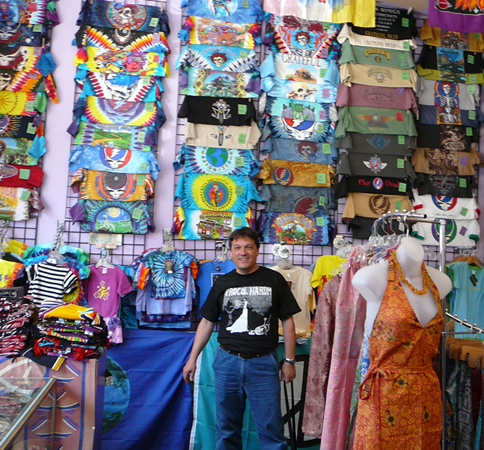 |
| A typical store in the Haight/Ashbury district |
San Francisco, being the hub of liberal activism, also has great influence on the look and feel of the city. Especially when visiting the district of Haight and Ashbury, you get a good sense of the hippie feel when you walk the streets. There were countless number of smoke shops, bars, music stores in which you would attract the young adults.
Source:
http://web.archive.org/web/20050211032911/http://spur.org/documents/010701_article_03.shtm
http://www.mercer.com/referencecontent.htm?idContent=1307990
http://web.archive.org/web/20070710072642/http://www.sfgov.org/site/uploadedfiles/moed/economic_strat/ExecutiveSummary_EconomicPerformanceReview.pdf
-----------------------------------------------------------------------------------------------------------------
Chapter 10: San Francisco Media and Entertainment
San Francisco is recognizable in the United States for many other reasons. The cities performing arts center hosts one of the popular performing-art companies in the country. It is also very notable that San Francisco hosts the second largest opera company in North America.
Musuems
Musuems
- San Francisco Museum of Modern Art- It exhibits 20th Century and Contemporary Art and gets about 600,000 visits a year.
- California Academy of Science- A natural history museum.
- De Young Musuem - Fine arts musuem.
 |
| San Francisco Museum of Modern Art |
Media
- San Francisco Chronicle-It is equivalent to the Los Angeles Times we have here. It is the most widely read paper in northern Calfornia.
- San Francisco has the 6th largest television market and 4th largest radio market in the United States
 |
Sports/Recreation
- 49ers- San Francisco's longest hosted professional sports franchise.
- Giants-San Francisco's hosted professional baseball team.
- San Francisco Marathon - More than 21,000 participants.
 |
| Candlestick Park |
Source:
http://www.sfgate.com/sports/article/S-F-Marathon-26-2-miles-of-feel-good-pain-3223749.php
-----------------------------------------------------------------------------------------------------------------
-----------------------------------------------------------------------------------------------------------------
Chapter 11: Great Plains
Where the Great Plains is known to be the habitat for the American Bison, San Francisco and the bay Area are known to have important habitats of its own. The Dungeness crab, Pacific halibut, and Pacific salmon are three typical sea creatures that rely on the bay. Also, a few of the remaining salt marshes are located in this area. These salt marshes support a number of endangered species as well as providing services to animals such as the most famous route for birds in the Pacific; the Pacific Flyway.
Many Aquatic mammals have been recently recorded to re-colonize the Bay Area including the California Golden Beaver, and the North American River Otter.
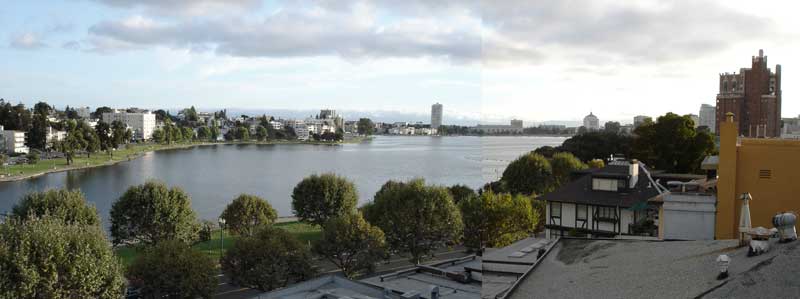 |
| Lake Merritt |
 |
| Don Edwards San Francisco Bay National Wildlife Refuge |
Many Aquatic mammals have been recently recorded to re-colonize the Bay Area including the California Golden Beaver, and the North American River Otter.
The San Francisco bay has had issues of pollution which has been known to harm the wildlife in that area. Industrial mining and other uses of mercury however have resulted in poisonous metal in the bay. Also, an incident in November 2007, where a ship collided with the Oakland Bay Bridge, had spilled over 58,000 gallons of bunker fuel which created the largest oil spill in that region since 1996.
Source:
http://articles.latimes.com/2007/nov/09/local/me-bay9
Source:
http://articles.latimes.com/2007/nov/09/local/me-bay9
http://www.bepress.com/archive/skinner_1962
http://www.birdnature.com/pacific.html
-----------------------------------------------------------------------------------------------------------------
http://www.birdnature.com/pacific.html
-----------------------------------------------------------------------------------------------------------------
Chapter 12/13: Rocky Mountain Region and Intermontane West
Although not as significant as the Rocky Mountains, the San
Francisco Bay Area
has some recognizable vertical reliefs. There are a few
mountains that with ridge and hill structures that were created by compressive
forces between the Pacific Plate and the North American plate. These ranges
provide for spectacular views in the Bay Area which include Marin County's Mount
Tamalpais at 2,571 feet. Contra Costa County's Mount Diablo at 3,849
feet, Alameda County's Mission Peak at 2,517 to 2,604 feet, and Santa Clara County's Mount Hamilton at 4,213 ft. Mount Hamilton is actually quite well known for its significant astronomical studies performed at its crowning Lick
Observatory. Although Tamalpais and Mission Peak are quite lower than the other ones mentioned,
Tamalpais has no other peaks and few hills nearby and Mission Peak is a coast facing, interior mountain and has a great view from both sides. |
| Mount Diablo |
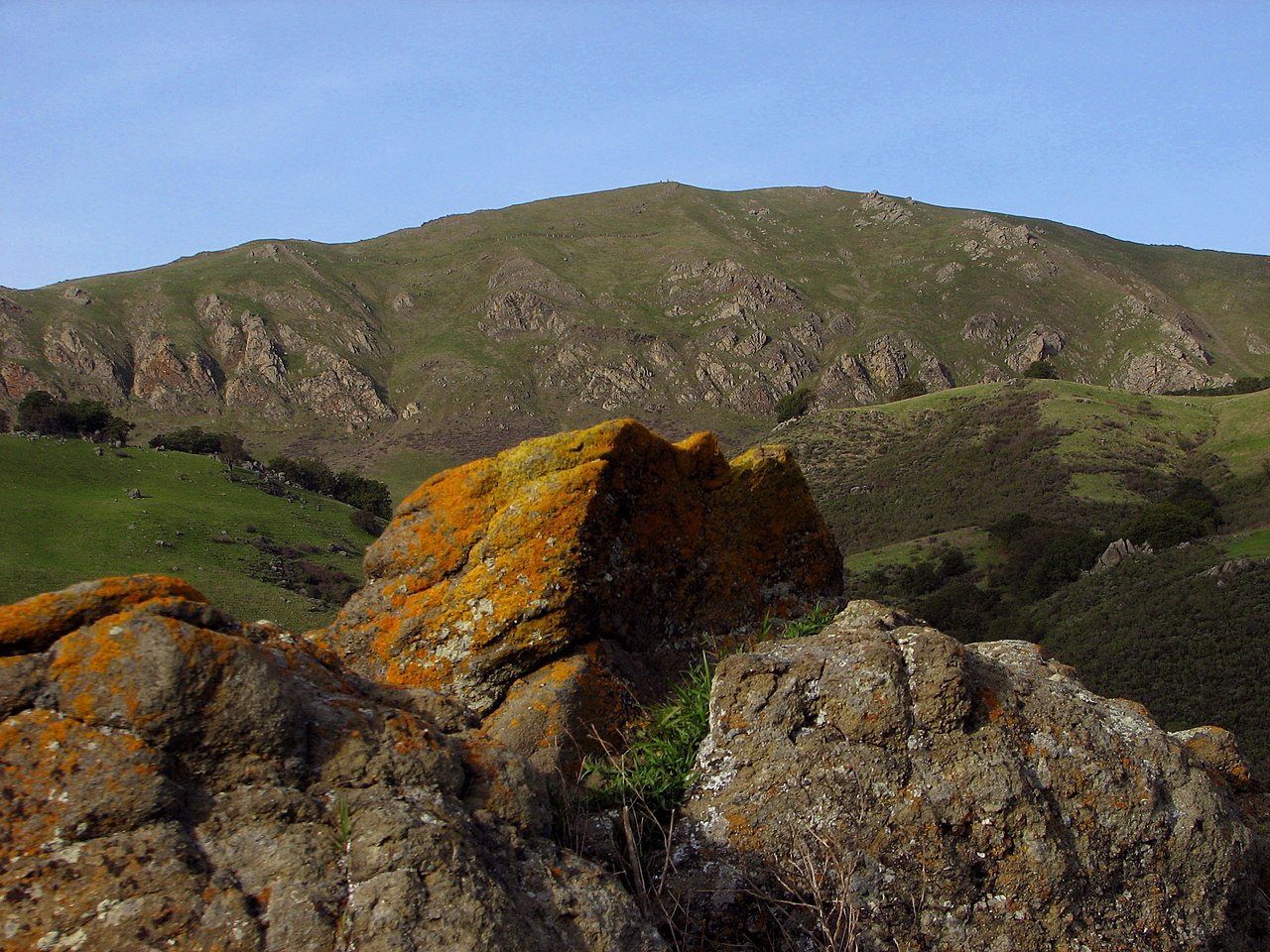 |
| Mission Peak |
There are three major ridges that follow parallel along the fault line.
- Sanata Cruz Mountains
- Berkely Hils which run through Misson Peak
- Diablo Range which includes Mount Diablo and Mount Hamilton
Similarly to the importance of the Colorado river, the San Francisco Bay Area has a couple of important waterways essential to the population in the area. The largest rivers are the Sacramento and San Joaquin Rivers
which drain into the Sacramento-San Joaquin River Delta and thereafter to Suisun
Bay. These two drain into the San Pablo Bay. Other major rivers in the North Bay area are the Napa River, the Petaluma
River, the Gualala River, and the Russian River. These two drain into the Pacific Ocean.
Source:
https://en.wikipedia.org/wiki/San_Francisco_Bay_Area
-----------------------------------------------------------------------------------------------------------------
Source:
https://en.wikipedia.org/wiki/San_Francisco_Bay_Area
-----------------------------------------------------------------------------------------------------------------
Chapter 14: MexAmerica
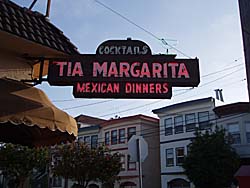 |
| Mexican restuarant in San Francisco |
Although the MexAmerica region is known for its high density
of hispanics, San Francisco has a significant amount of Hispanics as well. In
fact, over 15% of the population in San Francisco are from Hispanic origins. It
is also interesting to note that in nine of the nation's top ten metro areas
with the biggest Latino populations, Latinos' median household income on
average is about $40,000 a year which falls behind that of the general
population's $49,800. The only exception in the top ten list is San Francisco,
where Hispanics median household income is $55,000. They also do the best in
San Francisco in terms of sheer personal earnings, as opposed to household
income.
Nevertheless, the population of Hispanics in the San Francisco Bay Area
are growing at a much faster than that of the caucasian population and others.
San Mateo’s Latino population grew by 18 percent, and now makes up a quarter of
the county’s residents.
Source:
http://www.sfexaminer.com/local/2011/03/asians-latinos-continue-census-climb
-----------------------------------------------------------------------------------------------------------------
-----------------------------------------------------------------------------------------------------------------
Chapter 15: California
Knowing that California has the highest farm income in the United Sates, it is notable to recognize what San Francisco offers in the food market. Twenty million tons of food a year are produced within the 100 mile range of San Francisco. This includes more than 80 different crops and livestock products. The agriculture in this area bring in about $10 billion a year, which is more than a quarter of California's total agricultural income margin. The only major food group that is not produced with abundance relatively in the region is the grain, accounting for only four percent of the total production value. However most of the agricultural production does not come from the immediate Bay Area, but from the valleys beyond such area. The Bay Area however account fro about 14% of the total agricultural production. One-third of that comes from the valuable wine grape crops in Napa and Sonoma Counties.
 |
| The vineyards of Napa Valley |
Organic food production in the San Francisco is a small fraction of the total agricultural output. However, it takes up a significant percentage of direct-to consumer sales. The sales of organic food grew at an average annual rate of 18.6%.
It is interesting to note that the a great deal of what is produced in the area is not consumed in San Francisco or the entire 100 mile radius of the city. About 40% of California's agricultural production is actually exported to the rest of the country or oversea. Whereas, about a quarter of the food consumed in the state is actually imported from outside the Country. Therefore, San Francisco is known to export most of its production the area than domestically consume.
source:
http://www.farmland.org/programs/states/ca/Feature%20Stories/documents/Chap_1_foodshed.pdf
-----------------------------------------------------------------------------------------------------------------
source:
http://www.farmland.org/programs/states/ca/Feature%20Stories/documents/Chap_1_foodshed.pdf
-----------------------------------------------------------------------------------------------------------------
Chapter 16: The Pacific Northwest
 The Pacific Northwest gets its a significant amount of power and water from its dam. The San Francisco Bay Area gets some of its power and water from natural resources likewise. The San Francisco Public Utilities Commision (SFPUC) is the agency in San Francisco which provide with water and electric power services to the City and another 1.6 million people within three of the Bay Area counties. SFPUC provides fresh water from the Hetch Hetchy Reservoir to about 2.4 million people. Almost a third of that water is sent to people within San Francisco while the remaining is sent to Alameda, San Mateo and Santa Clara counties. In the Hetch Hetchy which is on the edge of the Yosemite was built the Shaughnessy Dam in the 1930's. Not only does it help with providing the water, it is also a large source of the electricity. Aside from the water and electricity, SFPUC is responsible for treating the wastewater before it is sent into the San Francisco Bay and Pacific Ocean.
The Pacific Northwest gets its a significant amount of power and water from its dam. The San Francisco Bay Area gets some of its power and water from natural resources likewise. The San Francisco Public Utilities Commision (SFPUC) is the agency in San Francisco which provide with water and electric power services to the City and another 1.6 million people within three of the Bay Area counties. SFPUC provides fresh water from the Hetch Hetchy Reservoir to about 2.4 million people. Almost a third of that water is sent to people within San Francisco while the remaining is sent to Alameda, San Mateo and Santa Clara counties. In the Hetch Hetchy which is on the edge of the Yosemite was built the Shaughnessy Dam in the 1930's. Not only does it help with providing the water, it is also a large source of the electricity. Aside from the water and electricity, SFPUC is responsible for treating the wastewater before it is sent into the San Francisco Bay and Pacific Ocean. |
| Hetch Hetchy reservoir |
Before the construction of the Hetch Hetchy Aqueduct, half of
San Francisco's water supply which was about 6 million gallons per day passed
through the Sunol temple. It then purchased by the
city of San Francisco in 1930 for US$40 million.
California is also known for generating wind power. The state has three primary regions where they have acres of windmills built to generate energy, including the Altamont Pass Wind Farm; a region in the Bay Area. These windmills provide for significant power to San Francisco and other bay area cities.
source:
http://www.earnfromanywhere.com/?p=542
http://en.wikipedia.org/wiki/San_Francisco_Public_Utilities_Commission
California is also known for generating wind power. The state has three primary regions where they have acres of windmills built to generate energy, including the Altamont Pass Wind Farm; a region in the Bay Area. These windmills provide for significant power to San Francisco and other bay area cities.
source:
http://www.earnfromanywhere.com/?p=542
http://en.wikipedia.org/wiki/San_Francisco_Public_Utilities_Commission
-----------------------------------------------------------------------------------------------------------------
Chapter 17: Hawai'i
The center focus of Hawai'i is its tourist attraction. San Francisco is a very attractive city for tourism as well, with its landmark beaches and parks. These beaches and parks are facilitated by the Golden Gate National Recreation Area (GGNRA). This unit in fact is one of the most visited of the nation park systems in all of United States at about 13 million visitors per year. One of the main attractions within (GGNRA) is the Ocean Beach. This beach runs along the west coast of San Francisco at the Pacific Ocean. Much like that of Hawai'i, Ocean Beach has a vibrant surfing community. The most popular part of the beach is at Kellys Cove. It is home to only the most dedicated San Francisco surfers similar to of North Shore of Oahu, Hawai'i.
There are more than 220 parks that are facilitated by the San Francisco Parks and Recreation department. The most popular and largest of which is the Golden Gate Park, which stretches from the center of the city to the Pacific Ocean. The area where the park was built over was originally covered by native sand dunes and grasslands. Then in the 1860s was created into the park we know today with the planting of non-native trees and plants. The park itself has several cultural attractions like the Japanese Tea Garden, and the San Francisco Botanical Garden.
 |
| Japanese Tea Garden |
There are more than 220 parks that are facilitated by the San Francisco Parks and Recreation department. The most popular and largest of which is the Golden Gate Park, which stretches from the center of the city to the Pacific Ocean. The area where the park was built over was originally covered by native sand dunes and grasslands. Then in the 1860s was created into the park we know today with the planting of non-native trees and plants. The park itself has several cultural attractions like the Japanese Tea Garden, and the San Francisco Botanical Garden.
Other attractive parks include Lake Merced, which is a fresh-water
lake surrounded by park area and the San Francisco Zoo. The only park managed
by the California State Park system is found in San Francisco, Candlestick
Point. This area is known to be the first of the state’s urban recreation
areas.
Source:
http://www.beachcalifornia.com/sanfran5.html
-----------------------------------------------------------------------------------------------------------------
-----------------------------------------------------------------------------------------------------------------
Subscribe to:
Posts (Atom)


